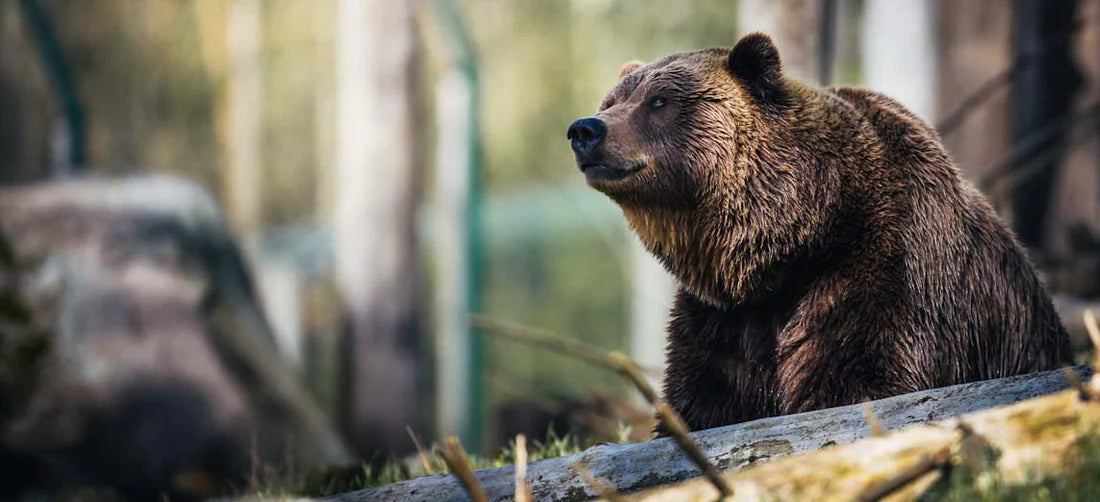What is the Bear's symbolism? When it comes to European totem animals, the Bear is central. It could even be described as royal, so often has it been associated with royalty or even divinity through the ages.
Sometimes adored for its power or wisdom, sometimes feared for its ferocity, the Bear fascinates all peoples. And very specifically the ancient peoples of Europe. Today, the bear's symbolism guides us to age-old virtues.
But what is the symbolism of the bear as a totem animal?
- The meaning and virtues associated with the Bear🌿
- The bear in prehistory 🪨
- Bears among the Vikings ⚔️
- Bears among the Celts and Gauls 🍀
- The bear in medieval times 🐻
- Modern virtues associated with the bear 💪
The meaning and virtues associated with the Bear
The bear has always been revered and feared at the same time. A symbol of power and protection, it features in numerous legends and folk traditions, and has been revered in the form of cults since prehistoric times. Over time, it came to be associated with royalty and even divinity. When we think of the King of the Forest, some see the Stag, others the Bear, for his strength, fighting spirit and territoriality.
Over time, he came to be associated with the following virtues:
Symbolism 1: Strength, robustness
- The bear symbolizes brute, savage strength.
- It also embodies robustness and determination in the face of hardship. The figure of the bear that continues to advance, its back studded with arrows, is not insignificant. It symbolizes his resistance.
Symbolism 2: Protecting the territory, the family
- The bear is a territorial animal. By extension, it also represents the father or mother of a family, ready to do anything to defend his or her own. It's the clan's opposition to society.
- It is also associated with maternal care and the survival instinct. The female bear, fiercely protecting her cubs, could also symbolize maternity and protection. This image of the bear as guardian of the family and the young is a powerful symbolism that has spanned the ages and still inspires us today ✨
Symbolism 3: Isolation, renewal
The Bear is a hibernating animal. It knows how to withdraw to regain its strength, to prepare for the battles to come. In certain spiritual traditions, it's a noble guide that leads us to surpass ourselves and show wisdom in our efforts.
The bear's hibernation may also have symbolized the cycle of life, death and rebirth for our ancestors. The bear's return in spring after a long period of sleep could be seen as a metaphor for resurrection and renewal, essential themes for societies dependent on natural cycles. And if you're interested in history, you'll know that individuals who resurrect after a period of dormancy are the kind of people who mark their era, don't you think?😇
In certain spiritual traditions, as in Siberia, the bear is seen as an ancestor of man. A distant relative, revered through dances and shamanic initiations. The knowledge of the ancients survives through him.

Totemic representation of the Bear by artist @Sleepy_Charly
The bear in prehistory!
Representations in Cave Art
Bears appear frequently in prehistoric rock paintings and engravings, particularly during the Upper Paleolithic period (around 40,000 to 10,000 years BC). These representations, found in caves across Europe such as the Chauvet cave in France, testify to the symbolic importance of the bear for prehistoric societies. These images may have served ritual, magical or symbolic purposes, indicating a form of respect or veneration for the animal. It is even assumed that tribal initiation rituals were used to get closer to this spiritual ancestor.
Bear rituals and worship
Archaeological discoveries, such as the deposition of bear bones in particular contexts, suggest that our distant ancestors practiced rituals dedicated to the bear. One of the best-known examples is the “bear cult” of the Neanderthals, where bear skulls were placed in specific positions, perhaps as part of religious ceremonies or hunting rituals. This practice indicates a belief in the spiritual power of the bear and an attempt to attract its protection or strength. At least, that's our modern guess! 📖
In short, in prehistoric times, the bear must have been much more than just an animal to early humans. It embodied values of power, renewal and protection, playing a central role in rituals and beliefs. Artistic representations and ritual practices bear witness to the profound veneration and symbolic importance of the bear in prehistoric societies.
The bear among the Vikings

During the Viking Age, and in the wider Germanic and Scandinavian world, the bear was revered by association with its warrior virtues. The bear was seen as a symbol of brute strength and indomitable courage.
Certain berserkers, warriors reputed to be invincible and completely unpredictable (for reasons we're still struggling to identify: mushrooms, rituals, training... Who's right!), sometimes even wore bear skins, seeking to channel the animal's spirit.
The runes on our Blason de l'Ours t-shirt recall this tradition, evoking notions of protection and power. It's not for nothing that the rune ᚦ, Thurisaz, is included in our design.
The bear among the Celts and Gauls
Among the Celts (and also the Gauls, by extension 😇 ), the bear was associated with Artio, goddess of hunting and nature, who was mostly worshipped by our Helvetian friends in Switzerland. Attached is a bronze statuette from the 2nd century, unearthed near Bern, in Switzerland.

Moreover, the legacy would continue to inspire Anglo-Saxon Celtic folklore, as the very name of the legendary King Arthur (Artorius) derives from the ancient Celtic word for bear. Here too, the bear symbolized strength, but also wisdom and the protection of nature. The oak branches added to our motif pay tribute to this deep connection between the bear and European forests.
Indeed, in ancient Celtic society, forests were managed by each tribe, which leads us to the comical observation that Gallic France was less forested than our own! (But the variety of trees prevailed over those of the douglas-fir plantations we're inflicted with today for their fast-growing, soil-acidifying 🫠 But that's another debate!)
Aside: The ancient world sometimes referred to the Celts as a people of the Forests and the Night. This is not insignificant, as the connection to protective woods, to the forest that both protects and takes away, is intrinsic to the symbolism of wild life among the Celts.
The bear in medieval times

During the Middle Ages, bears were often featured in bestiaries, works which depicted the real and mythical characteristics of animals. It was generally described as a noble animal, capable of great ferocity but also of gentleness, particularly in protecting its cubs. This duality made the bear a complex symbol, represented in medieval art and literature.
The bear was also hunted as a royal trial, and this is where the Irish Wolfhounds came into their own; they took part in hunting bears alongside kings, and would have been the only dogs capable of such a feat.
The modern virtues of the bear
Today, the bear continues to embody strong, timeless values. At least, for us it does 🍀 It's often seen as a symbol of strength and solidity, evoking resilience in the face of challenges. But also a symbol of family and protection, recalling the image of the bear protecting its cubs with fierce determination.
In fact, we've made a t-shirt out of it, right here. A totemic adaptation, safeguarding a long tradition of forgotten legends and folklore: Power, protection and wisdom, while embodying contemporary values of strength, solidity and family!🌿
If you've learned something from this article, we urge you to share it with others, to help them discover the symbolism of the Bear among our ancestors!
Uriel of Runes de Chêne




